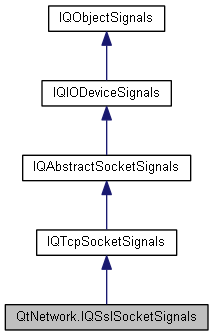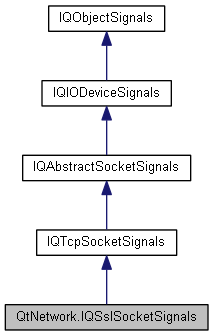|
Qyoto
4.0.5
Qyoto is a C# language binding for Qt
|
|
Qyoto
4.0.5
Qyoto is a C# language binding for Qt
|


Public Member Functions | |
| void | Encrypted () |
| | |
| void | PeerVerifyError (QSslError error) |
| | |
| void | SslErrors (System.Collections.Generic.List< QSslError > errors) |
| | |
| void | ModeChanged (QSslSocket.SslMode newMode) |
| | |
| void | EncryptedBytesWritten (long totalBytes) |
| | |
| void QtNetwork.IQSslSocketSignals.Encrypted | ( | ) |
This signal is emitted when QSslSocket enters encrypted mode. After this signal has been emitted, QSslSocket::isEncrypted() will return true, and all further transmissions on the socket will be encrypted.
See also QSslSocket::connectToHostEncrypted() and QSslSocket::isEncrypted().
| void QtNetwork.IQSslSocketSignals.EncryptedBytesWritten | ( | long | totalBytes | ) |
This signal is emitted when QSslSocket writes its encrypted data to the network. The written parameter contains the number of bytes that were successfully written.
This function was introduced in Qt 4.4.
See also QIODevice::bytesWritten().
| void QtNetwork.IQSslSocketSignals.ModeChanged | ( | QSslSocket.SslMode | newMode | ) |
This signal is emitted when QSslSocket changes from QSslSocket::UnencryptedMode to either QSslSocket::SslClientMode or QSslSocket::SslServerMode. mode is the new mode.
See also QSslSocket::mode().
| void QtNetwork.IQSslSocketSignals.PeerVerifyError | ( | QSslError | error | ) |
QSslSocket can emit this signal several times during the SSL handshake, before encryption has been established, to indicate that an error has occurred while establishing the identity of the peer. The error is usually an indication that QSslSocket is unable to securely identify the peer.
This signal provides you with an early indication when something's wrong. By connecting to this signal, you can manually choose to tear down the connection from inside the connected slot before the handshake has completed. If no action is taken, QSslSocket will proceed to emitting QSslSocket::sslErrors().
This function was introduced in Qt 4.4.
See also sslErrors().
| void QtNetwork.IQSslSocketSignals.SslErrors | ( | System.Collections.Generic.List< QSslError > | errors | ) |
Returns a list of the last SSL errors that occurred. This is the same list as QSslSocket passes via the sslErrors() signal. If the connection has been encrypted with no errors, this function will return an empty list.
See also connectToHostEncrypted().